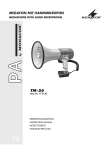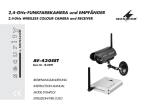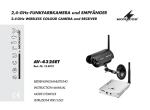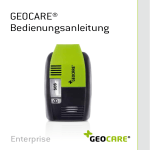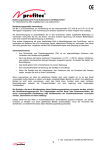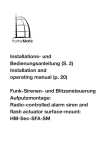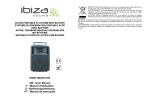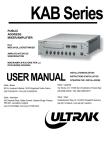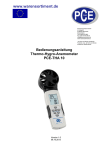Download TXM-48 - Monacor
Transcript
MEGAFON MIT FUNKMIKROFON MEGAPHONE WITH WIRELESS MICROPHONE TXM-48 Best.-Nr. 17.2380 BEDIENUNGSANLEITUNG INSTRUCTION MANUAL MODE D’EMPLOI ISTRUZIONI PER L’USO D Bevor Sie einschalten ... A Wir wünschen Ihnen viel Spaß mit Ihrem neuen Gerät von MONACOR. Bitte lesen Sie diese Bedienungsanleitung vor dem Betrieb gründlich durch. Nur so lernen Sie alle Funktionsmöglichkeiten kennen, vermeiden Fehlbedienungen und schützen sich und Ihr Gerät vor eventuellen Schäden durch unsachgemäßen Gebrauch. Heben Sie die Anleitung für ein späteres Nachlesen auf. CH GB We wish you much pleasure with your new MONACOR unit. Please read these operating instructions carefully prior to operating the unit. Thus, you will get to know all functions of the unit, operating errors will be prevented, and yourself and the unit will be protected against any damage caused by improper use. Please keep the operating instructions for later use. The English text starts on page 4. Der deutsche Text beginnt auf der Seite 4. F Avant toute mise en service ... B Nous vous souhaitons beaucoup de plaisir à utiliser cet appareil MONACOR. Lisez ce mode dʼemploi entièrement avant toute utilisation. Uniquement ainsi, vous pourrez apprendre lʼensemble des possibilités de fonctionnement de lʼappareil, éviter toute manipulation erronée et vous protéger, ainsi que lʼappareil, de dommages éventuels engendrés par une utilisation inadaptée. Conservez la notice pour pouvoir vous y reporter ultérieurement. CH La version française se trouve page 7. 2 Before you switch on ... I Prima di accendere ... Vi auguriamo buon divertimento con il vostro nuovo apparecchio di MONACOR. Leggete attentamente le istruzioni prima di mettere in funzione lʼapparecchio. Solo così potete conoscere tutte le funzionalità, evitare comandi sbagliati e proteggere voi stessi e lʼapparecchio da eventuali danni in seguito ad un uso improprio. Conservate le istruzioni per poterle consultare anche in futuro. Il testo italiano inizia a pagina 7. 3 4 2 LOW RED HI GREEN BATTERY 5 OFF SIREN ALARM 4 3 5 6 6 2 7 1 8 F0 1 23 45 67 B CDE ON 9 OFF 10 TUNER /AUX 89A CH SEL 1 10 DC-12V MIC. AUX 8 11 9 WIRELESS MICROPHONE TXM-48 12 15 ON OFF BATT. 3 B CD 89A 18 19 01 67 17 14 EF 45 16 23 13 7 D A Auf der ausklappbaren Seite 3 finden Sie alle beschriebenen Bedienelemente und Anschlüsse. CH 1 Übersicht der Bedienelemente und Anschlüsse 1.1 Megafon (Abb. 1 und 2) 1.2 Kabelgebundenes Mikrofon (Abb. 3) G 12 Sprechtaste: beim Sprechen gedrückt halten Die Taste lässt sich durch Schieben in Pfeilrichtung einrasten: das Mikrofon bleibt dann eingeschaltet. Verwenden Sie für die Reinigung nur ein trockenes oder leicht angefeuchtetes, weiches Tuch, auf keinen Fall Chemikalien oder aggressive Reinigungsmittel. G Werden die Geräte zweckentfremdet, falsch bedient oder nicht fachgerecht repariert, kann keine Haftung für daraus resultierende Sach- oder Personenschäden und keine Garantie für die Geräte übernommen werden. G Bei längerem Nichtgebrauch der Geräte sollten die Batterien herausgenommen werden. So bleiben die Geräte bei einem eventuellen Auslaufen der Batterien unbeschädigt. 13 Lautstärkeregler 1.3 Funkmikrofon (Abb. 4) 1 M8-Gewindebuchse für die Montage auf ein Stativ 14 Fach für zwei Batterien der Größe Mignon/AA 2 Halter für das kabelgebundene Mikrofon 16 Kanalwahlschalter; zum Drehen des Schalters den Einstellschlüssel (17) verwenden 3 Antenne 4 Anzeige für die Stromversorgung des Megafons grün: Stromversorgung ausreichend rot: Stromversorgung zu gering (z. B. bei fast verbrauchten Batterien) 5 Schalter zum Ein-/Ausschalten der Sirene 6 Drehknopf TUNER/AUX zum Ein-/Ausschalten des Megafons und Einstellen der Lautstärke bei dem Betrieb des Megafons mit dem Funkmikrofon (→ Kap. 6.3) oder mit einem am Eingang AUX (11) angeschlossenen Audiogerät (→ Kap. 6.4) 7 Drehschalter zur Wahl des Empfangskanals für die Funkübertragung; zum Drehen des Schalters den Einstellschlüssel (17) des Funkmikrofons verwenden 8 Kleinspannungsbuchse (∅ 5,5 mm, Mittelkontakt ∅ 2,1 mm; Mittelkontakt = Pluspol) für den Anschluss an eine externe 12-V-Stromversorgung, z. B. Netzgerät, Autobatterie 9 Schnappverschluss des Batteriefachs 15 Schraubkappe für das Batteriefach (14) 18 Anzeige für den Ladezustand der Batterien: beim Ein-/Ausschalten leuchtet sie kurz rot auf; leuchtet sie im Betrieb, sind die Batterien fast erschöpft 19 Ein-/Ausschalter 2 VORSICHT Betreiben Sie das Megafon niemals in Ohrnähe einer anderen Person! Durch die verstärkte Stimme oder durch ein Rückkopplungspfeifen können Gehörschäden verursacht werden. G Legen Sie die Geräte nicht in feuchter Umgebung ab und schützen Sie sie vor großer Hitze (zulässiger Einsatztemperaturbereich 0–40 °C). 11 Eingang AUX (3,5-mm-Klinke) für den Anschluss an den Line- oder Kopfhörerausgang eines Audiogerätes wie z. B. Kassettenrecorder, Radio G Vermeiden Sie es, die Geräte im Regen zu verwenden. Achten Sie darauf, dass keine Flüssigkeit in die Geräte gelangt. All operating elements and connections described can be found on the fold-out page 3. 1.2 Cable microphone (fig. 3) 1 13 Volume control Operating Elements and Connections 1.1 Megaphone (figures 1 and 2) 1 M8 threaded jack for mounting the megaphone onto a stand 2 Support for the cable microphone 3 Antenna 4 Indicating LED for power supply of the megaphone green: power supply is sufficient red: power supply is insufficient (e. g. if the batteries are almost exhausted) 7 Rotary switch for selecting the receiving channel for the wireless transmission; for turning the switch, use the adjusting key (17) of the wireless microphone 8 Low voltage jack (∅ 5.5 mm, centre contact ∅ 2.1 mm; centre contact = positive pole) for connection to an external 12 V power supply, e. g. power supply unit, car battery 9 Snap lock of the battery compartment 4 G No guarantee claims for the units and no liability for any resulting personal damage or material damage will be accepted if the units are used for other purposes than originally intended, if they are not correctly operated, or not repaired in an expert way. G If the units are not used for a longer period, remove the batteries to prevent damage to the units due to battery leakage. 14 Compartment for two batteries of size AA If the units are to be put out of operation definitively, take them to a local recycling plant for a disposal which is not harmful to the environment. 15 Screw cap for the battery compartment (14) 16 Channel selector switch; for turning the switch, use the adjusting key (17) 17 Adjusting key for the channel selector switch (16) 18 Battery status LED: it will shortly show red when the microphone is switched on or off; if it lights up during operation, the batteries are almost exhausted 19 On/off switch 2 Safety Notes The units (wireless microphone and megaphone) correspond to all required directives of the EU and are therefore marked with . CAUTION Never operate the megaphone close to anyoneʼs ears; the amplified voice or howling may cause hearing damage! Ausstattung Das TXM-48 ist ein leistungsstarkes 45-W-Megafon mit einschaltbarer Sirene. Es kann mit Batterien oder über eine externe 12-V-Stromversorgung betrieben werden. Das Megafon wird mit einem kabelgebundenen Handmikrofon und einem Funkmikrofon geliefert. Die Funkübertragung findet im Frequenzbereich 863,05 – 864,95 MHz statt. Der regelbare AUX-Eingang bietet zusätzlich die Möglichkeit, ein Audiogerät, wie z. B. Kassettenrecorder, Radiorecorder, tragbarer CD-Spieler usw., anzuschließen. Das Megafon kann frei aufgestellt oder über die M8-Gewindebuchse [(1) in Abb. 1] auf ein Stativ montiert werden. 1.3 Wireless microphone (fig. 4) Dead batteries or defective rechargeable batteries do not belong in the household rubbish; always take them to a special waste disposal (e. g. collection container at your retailer). 3 Features The TXM-48 is a powerful 45 W megaphone with siren feature. It can be operated with batteries or via an external 12 V power supply. The megaphone is supplied with a hand-held cable microphone and a wireless microphone. The wireless transmission is made in the frequency range of 863.05 – 864.95 MHz. The adjustable AUX input also allows connection of an audio unit, e. g. cassette recorder, radio recorder, portable CD player, etc. The megaphone can be placed as desired or mounted onto a stand via the M8 threaded jack [(1) in fig. 1]. G Never put down the units in humid environments and protect them against excessive heat (admissible ambient temperature range 0 – 40 °C). G Never use the units in the rain. Make sure that no liquid will penetrate the units. 3.1 Conformity and approval of the wireless transmission system G For cleaning only use a soft cloth, dry or slightly damp; never use chemicals or aggressive detergents. Herewith, MONACOR INTERNATIONAL declare that the wireless transmission system TXM-48 is in accordance with the basic requirements and the 10 Connection jack MIC for the cable microphone 11 AUX input (3.5 mm jack) for connection to the line output or headphone output of an audio unit, e. g. cassette recorder, radio 3 12 Talk button: keep pressed while talking To lock the button, push it in arrow direction: the microphone will remain switched on. 5 Switch for activating/deactivating the siren 6 Rotary knob TUNER/AUX for switching the megaphone on/off and for adjusting the volume while operating the megaphone with the wireless microphone (→ chapter 6.3) or with an audio unit connected to the AUX input (11) [→ chapter 6.4] Werfen Sie verbrauchte Batterien bzw. defekte Akkus nicht in den Hausmüll, sondern geben Sie sie nur in den Sondermüll (z. B. Sammelbehälter bei Ihrem Einzelhändler). Hinweise für den sicheren Gebrauch Die Geräte (Funkmikrofon und Megafon) entsprechen allen erforderlichen Richtlinien der EU und sind deshalb mit gekennzeichnet. 10 Anschlussbuchse MIC für das kabelgebundene Mikrofon GB Sollen die Geräte endgültig aus dem Betrieb genommen werden, übergeben Sie sie zur umweltgerechten Entsorgung einem örtlichen Recyclingbetrieb. 17 Einstellschlüssel für den Kanalwahlschalter (16) 3.1 Konformität und Zulassung Funkübertragungssystem für das Hiermit erklärt MONACOR INTERNATIONAL, dass sich das Funksystem TXM-48 in Übereinstimmung mit den grundlegenden Anforderungen und den übrigen einschlägigen Bestimmungen der Richtlinie 1999/5/EG befindet. Das System ist für den Betrieb in den EU- und EFTA-Staaten allgemein zugelassen und anmelde- und gebührenfrei. 4 Stromversorgung des Megafons Das Gerät kann wahlweise über Batterien oder eine externe 12-V-Stromversorgung versorgt werden. Bei Anschluss einer externen Stromversorgung werden die eingesetzten Batterien abgeschaltet. Während des Betriebs wird die Stromversorgung über die Anzeige BATTERY (4) angezeigt: Anzeige leuchtet grün: Stromversorgung ist ausreichend Anzeige leuchtet rot: Stromversorgung ist zu gering (z. B. bei fast verbrauchten Batterien) 4.1 Einsetzen von Batterien 1) Den Schnappverschluss (9) des Batteriefachs kräftig nach unten drücken: Der Batteriefachdeckel klappt auf. 2) Den Kunststoffbehälter aus dem Batteriefach nehmen und in diesen zehn Batterien (oder Akkus) der Größe Mono/D einsetzen. Dabei auf die richtige Polarität achten (→ Aufdruck des Behälters). 3) Den Behälter mit den Batterien wieder in das Batteriefach setzen und den Batteriefachdeckel kräftig zudrücken, sodass der Schnappverschluss einrastet. other relevant regulations of the directive 1999/5/EC. The system is licence free and generally approved for operation in EU and EFTA countries. 4 Power Supply of the Megaphone The unit can either be supplied with power via batteries or via an external 12 V power supply. If an external power supply is connected, the inserted batteries will be switched off. During operation, the power supply will be indicated via the LED BATTERY (4): LED shows green: power supply is sufficient LED shows red: power supply is insufficient (e. g. if the batteries are almost exhausted) 4.1 Inserting batteries 1) Push hard to disengage the snap lock (9) of the battery compartment: The battery compartment cover will open. 2) Remove the plastic container from the battery compartment and insert ten (rechargeable) batteries of size D. Observe the correct polarity (→ imprint on the container). 3) Replace the container into the battery compartment and push hard to close the battery compartment cover so that the snap lock will engage. 4.2 External power supply To connect an external 12 V power supply, e. g. 12 power supply unit, 12 V battery, remove the protection cap from the jack DC-12V (8) and connect the power supply via a low voltage plug 5.5 mm/ 2.1 mm (outside/inside diameter). The positive pole must be at the centre contact of the plug. The connection cable must be protected by a 5 A fuse. 4.2 Externe Stromversorgung Zum Anschluss einer externen 12-V-Stromversorgung, z. B. 12-V-Netzgerät, 12-V-Batterie, die Schutzkappe über der Buchse DC-12V (8) abnehmen und die Stromversorgung über einen Kleinspannungsstecker 5,5 mm/2,1 mm (Außen-/Innendurchmesser) anschließen. Am Mittelkontakt des Steckers muss der Pluspol liegen. Die Anschlussleitung muss mit einer 5-A-Sicherung abgesichert werden. Als externe Stromversorgung kann auch eine 12-V-Autobatterie, deren Minuspol an Masse liegt, verwendet werden. Hierzu das beiliegende Adapterkabel an die Buchse DC-12V anschließen und mit der Zigarettenanzünder-Buchse im Auto verbinden. (Für einen optimalen elektrischen Kontakt sollte diese nicht durch Zigarettenasche verschmutzt sein. Ggf. mit einem weichen, trockenen Tuch säubern.) Eine 5-A-Sicherung ist im vorderen Teil des Steckers bereits integriert. Zum Auswechseln der Sicherung die Rändelmutter herausdrehen. 5 Stromversorgung des Funkmikrofons 2) In das Mikrofon sprechen und dabei die Sprechtaste (12) auf der linken Seite des Mikrofons gedrückt halten. Das Mikrofon sollte beim Sprechen so nah wie möglich vor den Mund gehalten werden. Die Sprechtaste kann durch Schieben in Pfeilrichtung eingerastet werden: das Mikrofon bleibt dann eingeschaltet. 4) Nach dem Betrieb das Mikrofon auf die Mikrofonhalterung (2) stecken. Bei eingerasteter Sprechtaste nicht vergessen, diese nach dem Betrieb wieder zu lösen, um unnötigen Stromverbrauch zu vermeiden. 6.2 Funkverbindung einrichten Es sind 9 Übertragungskanäle im Frequenzbereich 863,05 – 864,95 MHz verfügbar. Frequenz 0 863,05 MHz 1 863,25 MHz 2 863,55 MHz 3 863,75 MHz 4 864,05 MHz 5 864,25 MHz 6 864,55 MHz 6.1 Betrieb mit kabelgebundenem Mikrofon 7 864,75 MHz 1) Das beiliegende kabelgebundene Mikrofon an das Megafon anschließen: Den Stecker des Mikrofonkabels in die Buchse MIC (10) stecken und mit der Rändelmutter des Steckers die Verbindung arretieren. 8 864,95 MHz 2) Zwei Batterien (oder Akkus) der Größe Mignon/AA unter Beachtung der Polarität in das Batteriefach (14) einsetzen. 3) Ist die Kanaleinstellung (→ Kap. 6.2.2) durchgeführt, die Kappe wieder aufschrauben. 6 Inbetriebnahme For external power supply, a 12 V car battery, with its negative pole connected to ground, can also be used. For this purpose, connect the adapter cable supplied to the jack DC-12V and to the cigarette lighter socket in the car. (To ensure optimum electrical contact, the socket should not be soiled by cigarette ash; clean it with a soft dry cloth, if necessary.) A 5 A fuse has already been integrated into the front part of the plug. To replace the fuse, unscrew the knurled nut. 5 Power Supply of the Wireless Microphone 1) Unscrew the screw cap (15). 2) Insert two (rechargeable) batteries of size AA into the battery compartment (14). Observe the polarity. 3) After adjusting the channel (→ chapter 6.2.2), screw on the cap again. 6 Operation 6.1 Operation with cable microphone 1) Connect the cable microphone supplied to the megaphone: Connect the plug of the microphone cable to the jack MIC (10) and secure the connection with the knurled nut of the plug. 2) Talk into the microphone while keeping the talk button (12) on the left side of the microphone pressed. While talking, hold the microphone as close to your mouth as possible. To lock the talk button, push it in arrow direction; the microphone will remain switched on. CH 3) Mit dem Regler (13) auf der rechten Seite des Mikrofons die gewünschte Lautstärke einstellen. Tritt ein Rückkopplungspfeifen auf, den Regler entsprechend zurückdrehen. Kanal 1) Die Schraubkappe (15) abschrauben. D A Werden bei Betrieb dieses Funksystems gleichzeitig andere drahtlose Übertragungssysteme betrieben, sollten die Funkfrequenzen der einzelnen Systeme 4) After operation, place the microphone onto the microphone support (2). If the talk button is locked, remember to unlock it after operation to prevent unnecessary power consumption. GB 6.2 Adjusting the channel for wireless transmission 9 transmission channels in the frequency range of 863.05 – 864.95 MHz are available. Channel Frequency 0 863.05 MHz 1 863.25 MHz 2 863.55 MHz 3 863.75 MHz 4 864.05 MHz 5 864.25 MHz 6 864.55 MHz 7 864.75 MHz 8 864.95 MHz If this wireless transmission system is operated together with other wireless transmission systems at the same time, the radio frequencies of the individual systems should be carefully matched to prevent interference. 6.2.1 Adjusting the channel on the megaphone Turn the channel selector switch CH SEL (7) on the megaphone in such a way that its arrow will point to the desired channel. For turning, use the adjusting key (17) of the wireless microphone. 3) Adjust the desired volume with the control (13) on the right side of the microphone. In case of howling, turn back the control accordingly. 5 D A CH sorgfältig aufeinander abgestimmt werden, um Störungen zu vermeiden. chen Kanal eingestellt sind (→ Kap. 6.2). Bei schlechtem oder gestörtem Empang überprüfen, ob: 6.2.1 Kanal am Megafon einstellen Am Megafon den Kanalwahlschalter CH SEL (7) so drehen, dass sein Pfeil auf den gewünschten Kanal zeigt. Zum Drehen kann der Einstellschlüssel (17) des Funkmikrofons verwendet werden. a) auf einem anderen Übertragungskanal der Empfang besser ist 6.2.2 Kanal am Funkmikrofon einstellen Am Funkmikrofon mit dem Einstellschlüssel (17) den Kanalwahlschalter (16) auf den gleichen Kanal drehen, der am Megafon eingestellt ist. Hinweis: Bei dem Funkmikrofon hat eine Änderung der Kanaleinstellung während des Betriebs keine Auswirkung. Deshalb nach jedem Kanalwechsel das Mikrofon kurz ausschalten und dann wieder einschalten. b) der Abstand zwischen Funkmikrofon und Megafon zu groß ist oder sich Hindernisse in der Übertragungstrecke befinden, die das Funksignal abschirmen können c) sich der Empfang durch Schwenken der Antenne verbessern lässt 5) Nach dem Betrieb nicht vergessen, den Drehknopf wieder auf OFF zu stellen und das Mikrofon mit dem Schalter (19) auszuschalten, um unnötigen Stromverbrauch zu vermeiden. 6.4 Betrieb mit einem Audiogerät 6.3 Betrieb mit Funkmikrofon 1) Die Antenne (3) senkrecht stellen. 2) Das Megafon auf Empfang des Funkmikrofons schalten: den Drehknopf TUNER/AUX (6) von OFF (Aus) auf ON (Ein) drehen. 3) Das Funkmikrofon einschalten: den Schalter (19) in die Position ON schieben. Die Anzeige BATT. (18) leuchtet kurz rot auf. Wenn die Anzeige während des Betriebs permanent leuchtet, sind die eingesetzten Batterien fast erschöpft. 4) Den Drehknopf TUNER/AUX je nach gewünschter Lautstärke aufdrehen und so nah wie möglich in das Mikrofon sprechen. Tritt ein Rückkopplungspfeifen auf, den Drehknopf entsprechend zurückdrehen. Wird am Megafon kein Mikrofonsignal empfangen, überprüfen, ob die Geräte auf den glei- 1) Den Line-Ausgang oder den Kopfhörerausgang des Audiogerätes (z. B. Radiorecorder, tragbarer CD-Spieler) mit der 3,5-mm-Klinkenbuchse AUX (11) verbinden. Hinweis: Bei Anschluss eines Stereo-Ausgangs einen Stereo-Mono-Adapterstecker verwenden, anderenfalls wird nur der linke Stereo-Kanal wiedergegeben. 2) Zum Einschalten des Megafons den Drehknopf TUNER/AUX (6) von OFF (Aus) auf ON (Ein) drehen. 6.5 Sirenenfunktion Zum Einschalten der Sirene den Sirenenschalter ALARM (5) auf Position SIREN stellen. In der Position OFF ist die Sirene abgeschaltet. 7 Technische Daten Ausstattung: . . . . . . . . . . . . 1 kabelgebundenes Mikrofon 1 Funkmikrofon Verstärkerleistung: . . . . . . . 45 W max. Mittl. Schalldruck (1 W/1 m): 124 dB Aux-Eingang: . . . . . . . . . . . 300 mV/30 kΩ Trägerfrequenz: . . . . . . . . . 863,05 – 864,95 MHz Abmessungen: . . . . . . . . . . ∅ 350 mm × 505 mm Gewicht (ohne Batterien): . . 3,4 kg Stromversorgung: . . . . . . . . 10 × 1,5-V-Monozelle (Größe D) oder extern 12 V /4 A Funkmikrofon Reichweite: . . . . . . . . . . . ca. 30 m Sendeleistung: . . . . . . . . < 10 mW (EIRP) Stromversorgung: . . . . . . 2 × 1,5-V-Mignonzelle (Größe AA) Abmessungen: . . . . . . . . . ∅ 48 × 235 mm Gewicht (ohne Batterien): 165 g Änderungen vorbehalten. 3) Das Audiogerät einschalten. Den Drehknopf TUNER/AUX je nach gewünschter Lautstärke aufdrehen. 4) Nach dem Betrieb nicht vergessen, den Drehknopf wieder auf OFF zu stellen, um unnötigen Stromverbrauch zu vermeiden. Diese Bedienungsanleitung ist urheberrechtlich für MONACOR ® INTERNATIONAL GmbH & Co. KG geschützt. Eine Reproduktion für eigene kommerzielle Zwecke – auch auszugsweise – ist untersagt. GB 6.2.2 Adjusting the channel on the wireless microphone Use the adjusting key (17) to set the channel selector switch (16) on the wireless microphone to the same channel adjusted on the megaphone. Note: A change of the channel adjustment during operation will not affect the wireless microphone. Therefore, shortly switch off the microphone each time a different channel has been adjusted, then switch it on again. 6.3 Operation with wireless microphone 1) Place the antenna (3) in a vertical position. 2) Switch the megaphone to reception of the wireless microphone: Set the rotary knob TUNER/ AUX (6) from OFF to ON. 3) Switch on the wireless microphone: Set the switch (19) to ON. The LED BATT. (18) will shortly show red. If the LED lights continuously during operation, the inserted batteries are almost exhausted. 4) Advance the rotary knob TUNER/AUX according to the desired volume, hold the microphone as close to your mouth as possible and talk into it. In case of howling, turn back the rotary knob accordingly. If the megaphone does not receive any microphone signal, check if the units are adjusted to the same channel (→ chapter 6.2). If the reception is poor or disturbed, check a) if the reception is better on a different transmission channel b) if the distance between the wireless microphone and the megaphone is too long or if there are any obstacles in the transmission path which may screen the radio signal c) if the reception can be improved by turning the antenna 5) After operation, remember to set the rotary knob to OFF and to switch off the microphone with the switch (19) to prevent unnecessary power consumption. 6.4 Operation with an audio unit 1) Connect the line output or the headphone output of the audio unit (e. g. radio recorder, portable CD player) to the 3.5 mm jack AUX (11). Note: When connecting a stereo output, use a stereo mono adapter plug, otherwise only the left stereo channel will be reproduced. 2) To switch on the megaphone, set the rotary knob TUNER/AUX (6) from OFF to ON. 3) Switch on the audio unit. Advance the rotary knob TUNER/AUX according to the desired volume. 4) After operation, remember to set the rotary knob to OFF to prevent unnecessary power consumption. All rights reserved by MONACOR ® INTERNATIONAL GmbH & Co. KG. No part of this instruction manual may be reproduced in any form or by any means for any commercial use. 6 6.5 Siren feature To activate the siren, set the siren switch ALARM (5) to the position SIREN. In the position OFF, the siren will be deactivated. 7 Specifications Features: . . . . . . . . . . . . . . 1 cable microphone 1 wireless microphone Amplifier power: . . . . . . . . . 45 W max. SPL (1 W/1 m): . . . . . . . . . 124 dB Aux input: . . . . . . . . . . . . . . 300 mV/30 kΩ Carrier frequency: . . . . . . . 863.05 – 864.95 MHz Dimensions: . . . . . . . . . . . . ∅ 350 mm × 505 mm Weight (without batteries): . 3.4 kg Power supply: . . . . . . . . . . 10 × 1.5 V battery, size D or external 12 V /4 A Wireless microphone Range: . . . . . . . . . . . . . . approx. 30 m Transmitting power: . . . . < 10 mW (EIRP) Power supply: . . . . . . . . 2 × 1.5 V battery, size AA Dimensions: . . . . . . . . . . ∅ 48 × 235 mm Weight (without batteries): . . . . . 165 g Subject to technical modification. Vous trouverez sur la page 3, dépliable, les éléments et branchements décrits. 1 Eléments et branchements 1.1 Mégaphone (schémas 1 et 2) 1 Prise filetée M8 pour le montage sur un pied 2 Support pour le microphone filaire 3 Antenne 4 LED pour lʼalimentation du mégaphone vert : alimentation suffisante rouge : alimentation trop faible (par exemple si les batteries sont presque épuisées) 5 Interrupteur Marche/Arrêt de la sirène 6 Potentiomètre rotatif TUNER/AUX pour mettre en marche/arrêter le mégaphone et régler le volume lorsque le mégaphone fonctionne avec le microphone sans fil (voir chapitre 6.3) ou avec un appareil audio branché à lʼentrée AUX (11) (voir chapitre 6.4) 1.2 Microphone filaire (schéma 3) 12 Touche Parole : maintenez-la enfoncée pour parler La touche peut être enclenchée si on la pousse dans le sens de le flèche : le microphone reste alors allumé. 13 Potentiomètre de réglage de volume 15 Couvercle à vis du compartiment batterie (14) 16 Sélecteur de canal : utilisez la clé de réglage (17) pour tourner le sélecteur 19 Interrupteur Marche/Arrêt G Elementi di comando e collegamenti 1 Presa filettata M8 per il montaggio su un treppiede 2 Supporto per il microfono collegato mediante cavo 3 Antenna 4 Spia di alimentazione del megafono verde: alimentazione sufficiente rosso: alimentazione scadente (p. es. con batterie quasi scariche) 5 Interruttore on/off della sirena 6 Manipola TUNER/AUX per accendere/spegnere il megafono e per impostare il volume quando il megafono funziona con il radiomicrofono (→ cap. 6.3) o con un apparecchio audio collegato allʼingresso AUX (11) (→ cap. 6.4). 7 Selettore per la ricezione del canale di ricezione per la trasmissione wireless; per girare il selettore usare la chiave di regolazione (17) del radiomicrofono 8 Presa per alimentazione DC (∅ 5,5 mm, contatto centrale ∅ 2,1 mm; contatto centrale = positivo) per il collegamento con unʼalimentazione esterna a 12 V, p. es. alimentatore, batteria dellʼauto 9 Chiusura a scatto del vano batteria 10 Presa di collegamento MIC per il microfono via cavo 11 Ingresso AUX (jack 3,5 mm) per il collegamento con lʼuscita di linea o cuffia di un apparecchio audio, p. es. registratore a cassette, radio Ne déposez pas les appareils dans un environnement humide et protégez-les dʼune chaleur élevée (plage de température de fonctionnement autorisée : 0 – 40 °C). 3 12 Tasto voce: tenerlo premuto mentre si parla. Spingendo il tasto in direzione della freccia si blocca ad incastro: il microfono rimane acceso. 13 Regolatore volume 14 Vano per due batteria tipo stilo/AA 15 Cappuccio a vite per il vano batterie (14) 16 Selettore canali; per girare il selettore usare la chiave di regolazione (17) 17 Chiave di regolazione per il selettore canali (16) 18 Spia per lo stato delle batterie: si accende brevemente di rosso durante lʼaccensione e lo spegnimento; se si accende durante il funzionamento significa che le batterie sono quasi scariche 19 Interruttore on/off in nessun caso prodotti chimici o detersivi aggressivi. G Nel caso di uso improprio, di impiego scorretto o di riparazione non a regola dʼarte degli apparecchi, non si assume nessuna responsabilità per eventuali danni consequenziali a persone o a cose e non si assume nessuna garanzia per gli apparecchi. G Nel caso di non utilizzo prolungato conviene togliere le batterie per evitare che perdano danneggiando gli apparecchi. Avvertenze di sicurezza ATTENZIONE Non usare mai il megafono vicino allʼorecchio di unʼaltra persona! Il forte volume della voce o il fischio dovuto al feedback acustico possono provocare danni allʼudito. G G G Non depositare gli apparecchi in un ambiente umido e proteggerli dal forte calore (temperatura dʼimpiego ammessa fra 0 e 40 °C). Cercate di non usare gli apparecchi sotto la pioggia. Fare in modo che non entri del liquido allʼinterno degli apparecchi. Per la pulizia usare solo un panno morbido asciutto oppure leggermente inumidito; non impiegare I Se si desidera eliminare lʼapparecchio definitivamente, consegnarlo per lo smaltimento ad unʼistituzione locale per il riciclaggio. Non gettare le batterie scariche nelle immondizie di casa bensì negli appositi contenitori. 3 Gli apparecchi (radiomicrofono e megafono) sono conformi a tutte le direttive richieste dellʼUE e pertanto porta la sigla . Equipement Le TXM-48 est un mégaphone puissant 45W avec une sirène commutable. Il peut fonctionner avec des batteries ou une alimentation externe de 12V. Le mégaphone est livré avec un micro main filaire et un micro sans fil. La transmission radio sʼeffectue dans la plage 863,05-864,95 MHz. Lʼentrée AUX réglable permet en plus de relier un appareil audio, par exemple magnétophone, radiocassette, lecteur CD portable... Le mégaphone peut être posé librement ou monté sur un pied via la prise filetée M8 [(1) sur le schéma 1]. 1.2 Microfono collegato mediante cavo (fig. 3) 2 CH Ne déposez pas les batteries usagées dans la poubelle domestique, déposez-les dans un container spécifique ou ramenez-les à votre détaillant. 1.3 Radiomicrofono (fig. 4) 1.1 Megafono (figg. 1 e 2) F B Conseils dʼutilisation et de sécurité Les appareils (mégaphone et micro sans fil) répondent à toutes les directives nécessaires de lʼUnion européenne et portent donc le symbole . 11 Entrée AUX (jack 3,5) pour brancher à la sortie casque ou ligne dʼun appareil audio, par exemple magnétophone, radio Evitez dʼutiliser lʼappareil sous la pluie. Veillez à ce quʼaucun liquide ne pénètre dans les appareils. Pour les nettoyer, utilisez uniquement un chiffon doux, sec ou légèrement humide, en aucun cas, de produits chimiques ou produits de nettoyage agressifs. Nous déclinons toute responsabilité en cas de dommages matériels ou corporels consécutifs si les appareils sont utilisés dans un but autre que celui pour lequel ils ont été conçus, sʼils ne sont pas correctement utilisés ou réparés par une personne habilitée ; de même, la garantie deviendrait caduque. En cas de non utilisation prolongée des appareils, retirez les batteries des appareils, elles pourraient couler et endommager les appareils. Lorsque les appareils sont définitivement retirés du service, vous devez les déposer dans une usine de recyclage adaptée pour contribuer à leur élimination non polluante. 18 Affichage pour lʼétat de charge des batteries : lors de lʼallumage/arrêt, elle brille brièvement en rouge ; si elle brille pendant le fonctionnement, les batteries sont presque épuisées ATTENTION Ne faites jamais fonctionner le mégaphone à proximité des oreilles dʼune autre personne ! Des dommages à lʼaudition peuvent être causés par une voix amplifiée ou un sifflement dû au feedback acoustique. 1 G 17 Clé de réglage pour le sélecteur de canal (16) 8 Prise basse tension (∅ 5,5 mm, contact médian ∅ 2,1 mm ; contact médian = pôle plus) pour brancher une alimentation externe 12 V, par exemple bloc secteur, batterie voiture. A pagina 3, se aperta completamente, vedrete sempre gli elementi di comando e i collegamenti descritti. G 14 Compartiment pour deux batteries de type R6 2 9 Fermeture à déclic du compartiment batterie G 1.3 Microphone sans fil (schéma 4) 7 Sélecteur rotatif pour choisir le canal de réception pour la transmission sans fil ; utilisez la clé de réglage (17) du micro sans fil pour tourner le sélecteur. 10 Prise de branchement MIC pour le microphone filaire G Equipaggiamento Il TXM-48 è un megafono potente a 45 W con possibilità di inserire la sirena. Può funzionare sia con batterie che con unʼalimentazione esterna a 12 V. Il megafono è equipaggiato con un microfono a mano collegato con un cavo e con un radiomicrofono. La trasmissione radio è effettuata nel range di frequenze 863,05 – 864,95 MHz. Lʼuscita AUX regolabile permette il collegamento di un apparecchio audio, p. es. di un registratore a cassette, un radio registratore, un lettore CD portatile ecc. Il megafono può essere sistemato liberamente oppure può essere montato su un treppiede mediante la presa filettata M8 [(1) di fig. 1]. 3.1 Conformità e omologazione La MONACOR INTERNATIONAL dichiara che i sistema radio TXM-48 è conforme a tutti i requisiti di base e alle rimanenti disposizioni in materia della 7 F B CH 3.1 Conformité et autorisation du système de transmission sans fil Par la présente, MONACOR INTERNATIONAL déclare que le système sans fil TXM-48 se trouve en conformité avec les exigences fondamentales et les réglementations inhérentes à la directive 1999/5/CE. Le système est autorisé pour un fonctionnement dans les pays de lʼUnion européenne et de lʼA.E.L.E et ne nécessite pas de déclaration. 4 Alimentation du mégaphone Lʼappareil peut être alimenté via des batteries ou une alimentation externe 12 V. Si vous branchez une alimentation externe, les batteries insérées sont déconnectées. Pendant le fonctionnement, lʼalimentation est signalé par la LED BATTERY (4) : la LED brille en vert : alimentation suffisante la LED brille en rouge : alimentation trop faible (par exemple si les batteries sont presque épuisées) 4.1 Insertion des batteries 1) Pressez fortement la fermeture à déclic (9) du compartiment batterie vers le bas : le couvercle du compartiment batterie sʼouvre. 2) Retirez le support plastique du compartiment batterie et insérez dix batteries ou accumulateurs de type R20. Veillez à respecter la polarité (reportez-vous au repère du support). 3) Remettez le support avec les batteries dans le compartiment batterie, et fermez le compartiment batterie en poussant fortement sur le couvercle de sorte que la fermeture à déclic sʼenclenche. I direttiva 1999/5/CE. Il sistema è omologato per lʼimpiego negli stati dellʼUE e dellʼEFTA, non richiede registrazione ed è esente da tasse. 4 Alimentazione del megafono Lʼapparecchio può essere alimentato a scelta tramite batterie o unʼalimentazione esterna a 12 V. Se è collegata unʼalimentazione esterna, le batterie interne vengono staccate. Durante il funzionamento, lʼalimentazione è visualizzata tramite la spia BATTERY (4): Spia verde: alimentazione sufficiente Spia rossa: alimentazione scadente (p. es. con batterie quasi scariche) 4.1 Inserimento delle batterie 1) Spingere fortemente in basso la chiusura a scatto (9) del vano batterie. Lo sportello si apre. 2) Togliere il contenitore di plastica dal vano batterie e metterci dieci batterie (anche ricaricabili) del tipo torcia (D), rispettando la corretta polarità (→ vedi la sovrastampa sul contenitore). 3) Sistemare il porta batterie nuovamente nel vano batterie e chiudere con forza il coperchio in modo che chiuda ad incastro. 4.2 Alimentazione esterna Per collegare unʼalimentazione esterna 12 V (p. es. alimentatore 12 V, batteria 12 V) togliere il cappuccio di protezione dalla presa DC-12 (8) e applicare la tensione mediante un connettore per alimentazione DC 5,5 mm/2,1 mm (diametro esterno/interno). Il positivo devʼessere sul contatto centrale. Il cavo di alimentazione deve essere protetto con un fusibile di 5 A. 8 4.2 Alimentation externe Pour brancher une alimentation externe 12 V, p. ex. bloc secteur 12 V, batterie 12 V, retirez la protection sur la prise DC-12V (8), et branchez lʼalimentation via une fiche à basse tension 5,5 mm/2,1 mm (Ø ext./int.). Le pôle plus doit être au contact médian de la fiche. Le câble de branchement doit être protégé par un fusible 5 A. Comme alimentation externe une batterie voiture 12 V dont le pôle moins est à la masse peut aussi être utilisée. Branchez le câble adaptateur livré à la prise DC-12V et à la prise allume-cigare dans la voiture. (Pour assurer un contact électrique optimal, cette prise ne devrait pas être salie par de la cendre de cigarettes. Si nécessaire, nettoyez-la avec un chiffon sec et doux.) Un fusible 5 A est déjà intégré dans la partie avant de la fiche. Tournez lʼécrou moleté pour changer le fusible. être tenu le plus proche que possible à la bouche pour parler. Si vous poussez la touche parole dans le sens de la flèche, la touche est enclenchée et le microphone reste allumé. 3) Avec le potentiomètre (13) sur le côté droit du microphone vous pouvez régler le volume souhaité. En cas de sifflement dû au feedback acoustique, tournez en arrière le potentiomètre en fonction. 4) Après le fonctionnement, placez le microphone sur le support du microphone (2). Si la touche prise de parole est enclenchée, nʼoubliez pas de la relâcher après lʼopération pour éviter une consommation inutile de courant. 6.2 Transmission sans fil 5 Alimentation du microphone sans fil 1) Dévissez le couvercle (15). 2) Insérez deux batteries (ou accumulateurs) de type R6 dans le compartiment batterie (14) en respectant la polarité. 3) Si le réglage du canal est déjà effectué (voir chapitre 6.2.2), revissez le couvercle. 9 canaux de transmissions sont disponibles dans la plage de fréquence 863,05 – 864,95 MHz : canal fréquence 0 863,05 MHz 1 863,25 MHz 2 863,55 MHz 3 863,75 MHz 4 864,05 MHz 5 864,25 MHz 6 864,55 MHz 6.1 Fonctionnement avec le microphone filaire 7 864,75 MHz 1) Reliez le microphone filaire livré au mégaphone : placez la fiche du câble microphone dans la prise MIC (10), et fixez la connexion avec lʼécrou moleté de la fiche. 2) Parlez dans le microphone et maintenez la touche parole (12) située sur le côté gauche du microphone, enfoncée. Le microphone devrait 8 864,95 MHz 6 Fonctionnement Anche una batteria auto con il negativo alla massa può servire come alimentazione esterna. In questo caso collegare il cavo adattatore in dotazione con la presa DC-12V ed inserirlo nellʼaccendisigaro della macchina (per garantire un contatto ottimale controllare che non ci sia della cenere di sigarette sul contatto; eventualmente pulire con un panno morbido, asciutto). Nella parte anteriore del connettore è integrato un fusibile di 5 A. Per sostituire il fusibile svitare il dado zigrinato. Si pendant le fonctionnement de ce système sans fil, dʼautres systèmes de transmission sans fil fonctionnent simultanément, il faut régler soigneusement les fréquences de chaque système les uns par rapport aux autres pour éviter toute interférence. 4) Al termine collocare il microfono nel suo supporto (2). Se è stato bloccato il tasto voce non dimenticare di sbloccarlo per evitare un consumo inutile di corrente. 6.2 Impostare il collegamento radio Sono disponibili 9 canali di trasmissione nel range di frequenze 863,05 – 864,95 MHz. Canale Frequenza 0 863,05 MHz 1) Svitare il cappuccio (15) a vite. 1 863,25 MHz 2) Inserire due batterie (anche ricaricabili) del tipo stilo/AA nel vano batteria (14), rispettando la polarità. 2 863,55 MHz 3 863,75 MHz 4 864,05 MHz 5 864,25 MHz 6 864,55 MHz 7 864,75 MHz 8 864,95 MHz 5 Alimentazione del radiomicrofono 3) Dopo aver eseguita lʼimpostazione dei canali, (→ cap. 6.2.2) riavvitare il cappuccio. 6 Messa in funzione 6.1 Funzionamento con microfono via cavo 1) Collegare il microfono in dotazione con il megafono, inserendo il connettore del cavo del microfono nella presa MIC (10) e bloccare il collegamento con il dado zigrinato del connettore. Se usando questo sistema wireless si usano contemporaneamente altri sistemi wireless di trasmissione, le radiofrequenze dei singoli sistemi dovrebbero essere bene sintonizzati fra di loro per escludere interferenze. 2) Parlare nel microfono tenendo premuto il tasto voce (12) sul lato sinistro del microfono. Tenere il microfono il più vicino possibile alla bocca. Il tasto voce può essere bloccato spingendolo in direzione della freccia; in questo caso il microfono rimane acceso. 6.2.1 Impostare il canale sul megafono Sul megafono girare il selettore CH SEL (7) in modo tale che la sua freccia indichi il canale desiderato. Per girarlo si può usare la chiave di regolazione (17) del radiomicrofono. 3) Con il regolatore (13) sul lato destro del microfono si può impostare il volume. Se si manifesta il fischio dovuto al feedback acustico occorre abbassare il regolatore. 6.2.2 Impostare il canale sul radiomicrofono Aiutandosi della chiave di regolazione (17), girare sul radiomicrofono il selettore canali (16) sullo stesso canale che è impostato sul megafono. 6.2.1 Réglage du canal sur le mégaphone Tournez le sélecteur de canal CH SEL (7) sur le mégaphone de telle sorte que sa flèche indique le canal voulu. Pour tournez utilisez la clé de réglage (17) du micro sans fil. 6.2.2 Réglage du canal sur le micro sans fil Sur le micro sans fil, utilisez la clé (17) pour tourner le sélecteur de canal (16) sur le même canal que celui réglé sur le mégaphone. Remarque : Sur le micro sans fil, une modification du réglage de canal pendant le fonctionnement nʼa pas dʼeffet. Cʼest pourquoi, après chaque changement de canal, éteignez brièvement le microphone puis rallumez-le. 6.3 Fonctionnement avec le micro sans fil 1) Placez lʼantenne (3) verticalement. 2) Commutez le mégaphone sur la réception du microphone sans fil: tournez le potentiomètre rotatif TUNER/AUX (6) de OFF (éteint) sur ON (allumé). 3) Allumez le microphone sans fil : poussez lʼinterrupteur (19) sur la position ON. La LED BATT. (18) brille brièvement en rouge. Si la LED brille pendant le fonctionnement en permanence, les batteries insérées sont presque épuisées. 4) Tournez le potentiomètre rotatif TUNER/AUX selon le volume souhaité, et parlez le plus près possible dans le microphone. En cas de sifflement dû au feedback acoustique, tournez en arrière le potentiomètre en fonction. Si sur le mégaphone aucun signal micro nʼest reçu, vérifiez si les appareils sont réglés sur le même canal (voir chapitre 6.2). En cas de mauvaise réception ou de réception perturbée, vérifiez si : a) la réception est meilleure sur un autre canal de transmission b) la distance entre le microphone sans fil et le mégaphone est trop grande ou si des obstacles se trouvent dans la voie de transmission, pouvant interférer c) la réception est meilleure si on tourne lʼantenne 5) Après le fonctionnement, nʼoubliez pas de mettre le potentiomètre rotatif sur OFF et déconnectez le microphone avec lʼinterrupteur (19) pour éviter une consommation inutile de courant. 6.4 Fonctionnement avec un appareil audio 1) Branchez la sortie Ligne ou la sortie casque de lʼappareil audio (p. ex. radiocassette, lecteur CD portable) à la prise jack 3,5 mm AUX (11). Remarque :Si vous branchez une sortie stéréo, utilisez un adaptateur stéréo mono sinon seul le canal gauche est restitué. 2) Pour allumer le mégaphone tournez le potentiomètre rotatif TUNER/AUX (6) de OFF (éteint) sur ON (allumé). 3) Allumez lʼappareil audio. Tournez le potentiomètre rotatif TUNER/AUX selon le volume souhaité. 4) Après le fonctionnement nʼoubliez pas de remettre le potentiomètre rotatif sur OFF pour éviter une consommation inutile de courant. 6.5 Fonction de la sirène Pour allumer la sirène, mettez lʼinterrupteur de la sirène ALARM (5) sur la position SIREN. Dans la position OFF la sirène est déconnectée. 7 F B CH Caractéristiques techniques Equipement : . . . . . . . . . . . 1 microphone filaire, 1 micro sans fil Puissance amplification : . . 45 W max. Pression sonore moyenne (1 W/1 m) : . . . . . . . . . . . . . 124 dB Entrée Aux : . . . . . . . . . . . . 300 mV/30 kΩ Fréquence porteuse : . . . . . 863,05 – 864,95 MHz Dimensions : . . . . . . . . . . . ∅ 350 mm × 505 mm Poids (sans batteries) : . . . 3,4 kg Alimentation : . . . . . . . . . . . 10 × batterie 1,5 V type R20 ou 12 V /4 A externe Microphone sans fil Portée : . . . . . . . . . . . . . 30 m environ Puissance émission : . . . < 10 mW (EIRP) Alimentation : . . . . . . . . . 2 × batterie 1,5 V type R6 Dimensions : . . . . . . . . . ∅ 48 × 235 mm Poids (sans batteries) : . 165 g Tout droit de modification réservé. Notice dʼutilisation protégée par le copyright de MONACOR ® INTERNATIONAL GmbH & Co. KG. Toute reproduction même partielle à des fins commerciales est interdite. N. B.: Sul radiomicrofono, una modifica delle impostazioni dei canali durante il funzionamento non ha effetto. Perciò, dopo ogni cambio del canale occorre spegnere brevemente il microfono e riaccenderlo poi. 6.3 Funzionamento con il radiomicrofono coli nella via di trasmissione che possano schermare il radiosegnale c) la ricezione migliora muovendo lʼantenna 5) Al termine non dimenticare di riportare la manopola su OFF e di spegnere il microfono con lʼinterruttore (19) per evitare un consumo inutile di corrente. 1) Portare lʼantenna (3) in posizione verticale. 2) Sul megafono impostare la ricezione del radiomicrofono: girare la manopola TUNER/AUX (6) da OFF (spento) a ON (acceso). 3) Accendere il radiomicrofono: spostare in posizione ON lʼinterruttore (19). La spia BATT. (18) si accende brevemente di rosso. Se la spia rimane accesa durante il funzionamento, significa che le batterie sono quasi scariche. 4) Aprire la manopola TUNER/AUX a seconda del volume desiderato e parlare tenendo il microfono il più vicino possibile alla bocca. Se si manifesta il fischio dovuto al feedback acustico occorre abbassare il regolatore. Se il megafono non riceve nessun segnale dal microfono, controllare se gli apparecchi sono impostati con lo stesso canale (→ cap. 6.2). Se la ricezione è scadente o disturbata, controllare se: a) con un altro canale di trasmissione, la ricezione è migliore b) la distanza fra radiomicrofono e megafono è troppo grande oppure se si trovano degli osta- 6.4 Funzionamento con un apparecchio audio 1) Collegare lʼuscita di linea o cuffia dellʼapparecchio audio (registratore a cassette, lettore CD portatile ecc.) con la presa jack 3,5 mm AUX (11). N. B.: Collegando unʼuscita stereo, usare un adattatore stereo/mono; altrimenti viene riprodotto solo il canale stereo di sinistra. 2) Per accendere il megafono, girare la manopola TUNER/AUX (6) da OFF (spento) a ON (acceso). 3) Accendere lʼapparecchio audio. Aprire la manopola TUNER/AUX a seconda del volume desiderato. 4) Al termine non dimenticare di riportare la manopola su OFF per evitare un consumo inutile di corrente. 7 Dati tecnici I Equipaggiamento: . . . . . . . 1 microfono collegato via cavo 1 radiomicrofono Potenza amplificatore: . . . . 45 W max. Pressione med. sonora (1 W/1 m): . . . . . . . . . . . . . 124 dB Ingresso Aux: . . . . . . . . . . . 300 mV/30 kΩ Frequenza portante: . . . . . 863,05 – 864,95 MHz Dimensioni: . . . . . . . . . . . . ∅ 350 mm × 505 mm Peso (senza batterie): . . . . 3,4 kg Alimentazione: . . . . . . . . . . 10 × batterie torcia 1,5 V (D) o esternamente 12 V /4 A Radiomicrofono Portata: . . . . . . . . . . . . . ca. 30 m Potenza di trasmissione: < 10 mW (EIRP) Alimentazione: . . . . . . . . 2 × batterie stilo 1,5 V (AA) Dimensioni: . . . . . . . . . . ∅ 48 × 235 mm Peso (senza batterie): . . 165 g 6.5 Sirena Per attivare la sirena portare lʼinterruttore ALARM (5) in posizione SIREN. In posizione OFF, la sirena è disattivata. Con riserva di modifiche tecniche. La MONACOR ® INTERNATIONAL GmbH & Co. KG si riserva ogni diritto di elaborazione in qualsiasi forma delle presenti istruzioni per lʼuso. La riproduzione – anche parziale – per propri scopi commerciali è vietata. 9 ® MONACOR INTERNATIONAL GmbH & Co. KG • Zum Falsch 36 • 28307 Bremen • Germany A-0775.99.02.06.2011 Copyright © by MONACOR INTERNATIONAL. All rights reserved.










